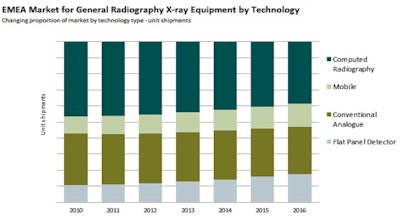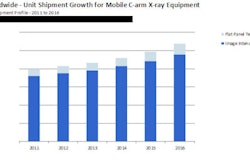
VIENNA - The fundamentals of static x-ray imaging have changed little in decades, prompting the majority of radiologists to pay scant attention to developments in this sector. However, the emergence and increasing use of flat-panel detector (FPD) technology is producing surprising results, improving workflow, image quality, cost of ownership, and patient safety. Below, we discuss how FPD technology is shaping the future of x-ray imaging.
Fixed-room x-ray
Fixed FPD x-ray rooms have become a mainstay of general radiography in Western Europe, offering near instant processing, lower dose, and near-seamless integration with healthcare IT solutions. While the initial cost of these systems caused many to question the benefits of FPD over analog and computed radiography (CR) x-ray, manufacturers have clearly established the long-term benefits in workflow and lifetime cost of ownership.
The main beneficiaries of this shift to FPD have primarily been larger hospitals and imaging centers; here, reducing processing time across large scan volumes has significant benefits both in terms of efficiency and cost. More recently, projected adoption of automated, multiplate systems and tables will further drive gains in efficiency, a positive outcome for many healthcare providers struggling in the current age of austerity.
Another notable trend has been the creation of a tiered FPD fixed-room market, providing more options in terms of configuration and panel type, allowing customization for the requirements of each unique user. Increased availability of lower priced fixed-room systems is also forecast to rapidly increase uptake of FPD systems in smaller institutions and emerging markets, particularly with panel prices continuing to decline year after year.
 |
| Source: InMedica |
Mobile
The evolution of mobile x-ray equipment has also been heavily shaped by FPD technology, particularly with more widespread use of wireless FPD technology. Mobile x-ray has often been overlooked on account of the lower price of systems and relatively low utilization compared to fixed-room systems. However, digital mobile x-ray systems offer even greater rewards in terms of efficiency, workflow, and cost savings over the system's lifespan than fixed rooms.
A large portion of mobile x-ray use occurs with patients too unwell or critical to be taken to the fixed system, most commonly in the intensive care or emergency medicine scenarios. Using wireless FPD mobile x-ray, maneuverability of the detector is improved, thereby reducing risk for the patient. Near-instant processing and review achieved with FPD also removes the need for the user to return to central processing locations to check the image, cutting out any need for the radiographer to return later to redo the same scan.
Wireless FPD mobile x-ray further offers inherent flexibility for hospitals, allowing sharing of wireless panels between mobile systems, or even between fixed-room and mobile systems. While in many large healthcare institutions equipment is in near-constant use, smaller facilities can make significant savings.
Retrofit
In terms of increasing accessibility to digital FPD x-ray, the development of retrofit FPD x-ray solutions could have the greatest impact of all. While onlookers may view retrofit upgrades as a short-term response to the current challenging economic climate, it may in fact bring FPD digital x-ray imaging within reach of those who need it most. In the wider Europe, Middle East, and Africa (EMEA) region, many parts of Eastern Europe, the Middle East, and Africa remain critically underserved by aging analog x-ray systems. Assuming FPD prices continue to decline as has been observed in the past five years, retrofit FPD solutions could soon be affordable for users in these regions. Furthermore, an increasing number of vendor-neutral retrofit solutions are commercially available, allowing more flexibility and choice for users.
Conclusion
The changes discussed above have all developed through product evolution of one technology, refining and developing products based on the demands of users in today's challenging healthcare market. FPD technology applied across all forms of general radiography is now allowing far greater customization of systems, evolving toward a truly "modular" market. Yet at the same time, it is making real changes to the way x-ray imaging is conducted, increasing efficiency, saving money, and providing tangible opportunity for emerging markets to adopt 21st-century imaging. Maybe it's time to take a closer look at what's on show in the x-ray exhibition this year.
Stephen Holloway is a senior market analyst in the healthcare IT research group at InMedica, a division of IHS. InMedica is a provider of market research and consultancy in the medical electronics industry.
Originally published in ECR Today on 11 March 2013.
Copyright © 2013 European Society of Radiology



















